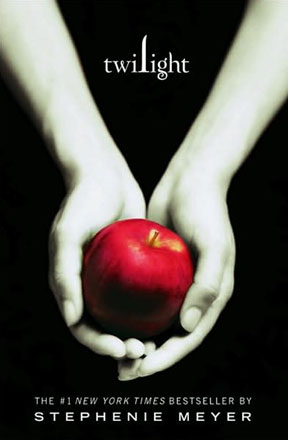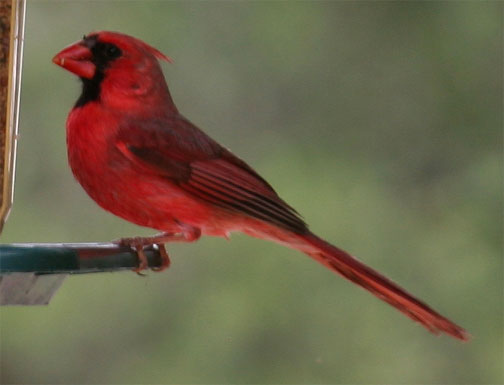Odds are that you’ve heard of the Twilight books, even if you’re not a teenage girl. If not the Twilight books, then probably the movie. Yesterday, in fact, it won five MTV movie awards, including Best Movie . . . and Best Kiss.
It’s the Best Kiss part that gets parents wondering about the appropriateness of the Twilight series for their children, whether on screen or in print. Plus, by now, just about everybody knows that the romance featured in these books is between a human being and a vampire. This sounds a little creepy, conjuring up pictures of bloody embraces and midnight murders.
I’ve had several parents ask me if they should let their daughters read the Twilight books. So I thought I might answer this question on my blog. If you’re not wondering about it, you might know someone who is.
 “Why am I in a position to answer this question?” you might wonder. Well, for one thing, I have read the books. All four of them. That’s over 2,400 pages. Why did I read these books? For a simple reason, really: I wanted to connect with my daughter, Kara, who is 14, and who loved these books. I figured that if I read them, it would be a way for me to enter her world. I thought it would give us a point of connection in her reality, a basis for lots of conversation that she’d enjoy. I was right. Kara and I spent many hours discussing the Twilight books. She seemed to appreciate the fact that I made this effort to relate to her and her experience. So if you were to ask me: “Should I read the Twilight books?” my answer would be: “By all means, if you have a teenage daughter (or granddaughter) who loves the books.”
“Why am I in a position to answer this question?” you might wonder. Well, for one thing, I have read the books. All four of them. That’s over 2,400 pages. Why did I read these books? For a simple reason, really: I wanted to connect with my daughter, Kara, who is 14, and who loved these books. I figured that if I read them, it would be a way for me to enter her world. I thought it would give us a point of connection in her reality, a basis for lots of conversation that she’d enjoy. I was right. Kara and I spent many hours discussing the Twilight books. She seemed to appreciate the fact that I made this effort to relate to her and her experience. So if you were to ask me: “Should I read the Twilight books?” my answer would be: “By all means, if you have a teenage daughter (or granddaughter) who loves the books.”
But should you let your daughter read the Twilight series in the first place? Or even your son? (I’ve phrased the question in terms of “your daughter” because these books are mostly being read and loved by girls, especially those in the teen years.) Usually, when parents ask about the appropriateness of a book for their children, they’re not asking a question of literary merit. Rather, their wondering if some of the book’s content is inappropriate. Generally, parents are worried about issues such as excessive violence, immoral sexuality, bad language, adult themes, and the like. So which of these show up in the Twilight books?
Warning: Spoilers ahead!
There is quite a bit of violence in the Twilight series, though it’s not what you might expect. The main family of vampires, of which Edward Cullen, the protagonist of the story, is a member, are “vegetarians.” This means they don’t suck human blood, or at least they try not to. Rather, they fulfill their need for blood with animals. (Oh-oh! PETA alert.) This means there aren’t scenes in the Twilight books like those that scared me half to death when I was a kid watching Saturday afternoon Dracula movies on TV. But, though you won’t see a bloody-faced Edward Cullen hovering over a badly-bitten Bella Swan, still there are many violent scenes throughout the series, mostly of a vampire vs. vampire variety. And these are extremely violent, though the author, Stephanie Meyer, exercises restraint in her depictions. (Perhaps one of the most horrific scenes in the books isn’t violent so much as gory, involving an unusual birth.) Given the violence in this series, it’s hard for me to imagine that kids less than twelve should read the books. Particularly impressionable teenagers may avoid them or have nightmares.
There is little bad language in the Twilight books. What’s there is something you’d hear on network television. Many of the themes of the books are clearly intended for those who are twelve and older.
So what about sex? Surely such a popular teenage romance series has plenty of it, the sort of sex that parents wouldn’t want their children to read about. Yes? No! One of the surprising features of the Twilight series is that it doesn’t include scenes of premarital sex or even petting. When sexual interaction occurs, it happens between married people and is described tactfully. You hear lots about emotions, but no descriptions of body parts or particular acts.
Except for kissing. There is a lot of kissing in the Twilight books. Lots and lots and lots. And these kissing scenes are often described extensively, though, once again, with a certain restraint. I don’t remember any descriptions of French kissing. But I do recall pages and pages of description of feelings that accompanied kissing. (As you can tell, I found all of this to be a little tedious. But if I were a teenager . . . . Whew!)
As I read through the Twilight series, I had to wonder why an author in today’s world would write a teenage romance series – and a wildly successful one at that – without including scenes of premarital sexual intimacy. That seems like a gutsy choice in today’s world, one I do admire. It turns out that Stephanie Meyer, the author of the series, is a Mormon wife and mother of three young boys. Mormons frown upon premarital sexual intercourse, so I expect that this helps to explain Meyer’s unusual and refreshing commitment to keeping sex within marriage.
Her storyline allows her to narrate the romance between two teenagers (well, Edward seems to be a teenager) that is “hot and heavy” but still relatively chaste, yet without being preachy. (I don’t mind preaching on sex, by the way, but it generally doesn’t sell teenage romance books.) Because Edward is a vampire, and because he is fighting his nature not to suck Bella’s blood, he has to restrain himself from physical expression with her. They can kiss, but only with limits. So the lack of premarital sex is explained more on the basis of Edward’s desire not to kill his beloeved than his (or their) moral convictions. This allows secular teenagers to read the book without feeling as if they’ve stumbled into a Mormon lecture on sexual ethics. Frankly, I find Meyer’s strategy to be brilliant here (not unlike that of J.K. Rolling, whose teenagers at Hogwarts do plenty of “snogging” but no “shagging.”)
Yet, in a surprising scene in one of the Twilight books (I think it was the third or the fourth), Bella is trying to get Edward to sleep with her before they are married. He ends up defending his commitment to abstinence on the basis of the Ten Commandments. He does not want to commit adultery, so to speak, with Bella.
For the most part, I enjoyed reading the Twilight books. The story is engaging, especially as it gets more complex in the later books. I found Meyer’s supernatural world to be curious. As you’ve probably heard, her vampires have little to do with the bloody monsters of the past. Rather, they are cultured, moral beings, at least some of them. They have supernatural skills that can be used for good as well as evil.
In my opinion, Stephanie Meyer is a clever storyteller and an okay writer. My impression, having read all four books in about a month, is that her skill as a writer significantly improved from the first book to the fourth book. She still doesn’t demonstrate the extraordinary skill of J.K. Rowling, however. But very few contemporary writers are in Rowling’s league when it comes to imagination and expression.
So, should you let your daughter (or son) read the Twilight books? If your point is for your daughter to be exposed to great literature, then I wouldn’t direct her to these novels. But if she wants to read them, then they’re probably okay for her if she is at least twelve. You don’t have to worry about the sexual content, unless you’re nervous about descriptions of kissing and the accompanying emotions. If you’re worried about the violence and gore, you may want to check out the fight scene at the end of the first book and the birth scene in the fourth book.
Perhaps one of the greatest reasons to let your daughter read the Twilight books is that it will give you an opportunity to enter her world. Because I let Kara read these books and because I read them too, I was able to talk with her about all sorts of things, including: writing, characterization, plot, dating, romance, relationships, marriage, monsters, etc. For me, the greatest reward of reading these novels was the chance to spend time with and to get to know my own daughter much better. And that, in the classic words of the MasterCard commercial, is priceless.
More from Beliefnet and our partners

